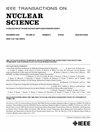用于分析 CMOS LC-Tank 振荡器中单次事件频率瞬变的上下文相关离群点检测技术
IF 1.9
3区 工程技术
Q3 ENGINEERING, ELECTRICAL & ELECTRONIC
引用次数: 0
摘要
本文提出了一种采用机器学习(ML)方法的上下文异常值检测技术,以提高重离子辐照运动中实验获得的数据的质量。由实验装置产生的伪影通常会损害测量数据的完整性和代表性。可以删除这些工件,也称为异常值,以确保准确表示被测设备(DUT)的一致数据集。由于被测物属性的动态性和可变性,异常值可能以各种形式表现出来,使得传统的异常值检测技术不足。为了解决这一挑战,我们提出了一种上下文离群值去除技术,该技术通过分割测试区域并使用隔离森林(ifforest)算法进行局部离群值检测,从而结合空间上下文。作为一个案例研究,该技术应用于重离子微束辐照平面螺旋电感器时获得的单事件频率瞬态(SEFT)数据,该数据位于集成的65nm CMOS LC-tank数字控制振荡器(DCO)电路中。图形并排比较显示了数据质量的显着改善,并通过提议的指标验证了这一点,该指标显示平均增强了4.4倍。本文章由计算机程序翻译,如有差异,请以英文原文为准。
Context-Dependent Outlier Detection Technique for Analysis of Single Event Frequency Transients in CMOS LC-Tank Oscillators
This article presents a contextual outlier detection technique employing machine learning (ML) method to improve the quality of experimentally obtained data from heavy-ion irradiation campaigns. Artifacts arising from the experimental setup often compromise the integrity and representativeness of the measured data. These artifacts, also known as outliers, can be removed to ensure a consistent dataset that accurately represents the device under test (DUT). Due to the dynamic and variable nature of the DUT properties, outliers may manifest in various forms, rendering conventional outlier detection techniques inadequate. To address this challenge, we present a contextual outlier removal technique that incorporates spatial context by segmenting the tested area and using the isolation forest (iForest) algorithm for localized outlier detection. As a case study, this technique is applied to single-event frequency transient (SEFT) data obtained during heavy-ion microbeam irradiation of a planar spiral inductor within an integrated 65-nm CMOS LC-tank digitally controlled oscillator (DCO) circuit. A graphical side-by-side comparison demonstrates significant improvements in data quality, validated by a proposed metric that shows an average enhancement of $4.4\times $ .
求助全文
通过发布文献求助,成功后即可免费获取论文全文。
去求助
来源期刊

IEEE Transactions on Nuclear Science
工程技术-工程:电子与电气
CiteScore
3.70
自引率
27.80%
发文量
314
审稿时长
6.2 months
期刊介绍:
The IEEE Transactions on Nuclear Science is a publication of the IEEE Nuclear and Plasma Sciences Society. It is viewed as the primary source of technical information in many of the areas it covers. As judged by JCR impact factor, TNS consistently ranks in the top five journals in the category of Nuclear Science & Technology. It has one of the higher immediacy indices, indicating that the information it publishes is viewed as timely, and has a relatively long citation half-life, indicating that the published information also is viewed as valuable for a number of years.
The IEEE Transactions on Nuclear Science is published bimonthly. Its scope includes all aspects of the theory and application of nuclear science and engineering. It focuses on instrumentation for the detection and measurement of ionizing radiation; particle accelerators and their controls; nuclear medicine and its application; effects of radiation on materials, components, and systems; reactor instrumentation and controls; and measurement of radiation in space.
 求助内容:
求助内容: 应助结果提醒方式:
应助结果提醒方式:


